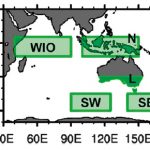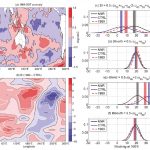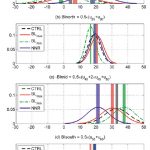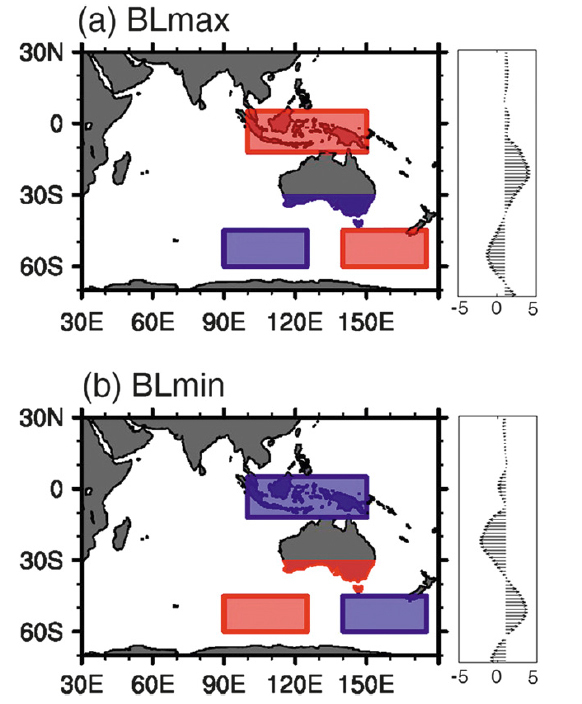Atmospheric Blocking
Background
Atmospheric blocking represents an important feature for mid-latitude regional climate. During a blocking situation, the large-scale zonal flow is impeded and meridional anomalies occur at upper levels. Blocking not only influences mid-latitude mean climate but also extreme events, such as heat waves and droughts. However, despite its importance, our understanding of the factors that affect intensity and frequency of atmospheric blocking and the exact physical mechanism behind these modulations is still limited, especially in the Southern Hemisphere. Furthermore, marked biases exist in the representation of blocking in climate models, but only a few modeling studies address specific factors for their potential in modulating blocking in the Southern Hemisphere.
Summary
Characteristics of atmospheric blocking in the SH are explored in atmospheric general circulation model (AGCM) simulations, with a particular focus on the Australia–New Zealand sector. Preferred locations of blocking in SH observations and the associated seasonal cycle are well represented in the AGCM simulations, but the observed magnitude of blocking is underestimated throughout the year, particularly in late winter and spring. This is related to overly zonal flow due to an enhanced meridional pressure gradient in the model, which results in a decreased amplitude of the longwave trough/ridge pattern. A range of AGCM sensitivity experiments explores the effect on SH blocking of tropical heating, midlatitude sea surface temperatures, and land–sea temperature gradients created over the Australian continent during austral winter. The combined effects of tropical heating and extratropical temperature gradients are further explored in a configuration that is favorable for blocking in the Australia–New Zealand sector with warm SST anomalies to the north of Australia, cold to the southwest of Australia, warm to the southeast, and cool Australian land temperatures. The blocking-favorable configuration indicates a significant strengthening of the subtropical jet and a reduction in mid-latitude flow, which results from changes in the thermal wind. While these overall changes in mean climate, predominantly forced by the tropical heating, enhance blocking activity, the magnitude of atmospheric blocking compared to observations is still underestimated. The blocking-unfavorable configuration with surface forcing anomalies of opposite sign results in a weakening subtropical jet, enhanced midlatitude flow, and significantly reduced blocking.
Further information
Hahn LC, Storelvmo T, Hofer S, Parfitt R, and Ummenhofer CC. (2020). Importance of orography for Greenland cloud and melt response to atmospheric blocking. Journal of Climate, 33, 4187-4206. Reprint
Hahn L, Ummenhofer CC, and Kwon Y-O. (2018). North Atlantic natural variability modulates emergence of widespread Greenland melt in a warming climate. Geophysical Research Letters, 45, 9171–9178. Reprint
Joyce TM, Kwon Y-O, Seo H, and Ummenhofer CC (2019). Meridional Gulf Stream shifts can influence wintertime variability in the North Atlantic storm track and Greenland blocking. Geophysical Research Letters, 46, 1702-1708. Reprint
Kwon Y-O, Seo H, Ummenhofer CC, and Joyce TM (2020). Impact of multidecadal variability in Atlantic SST on winter atmospheric blocking. Journal of Climate, 33, 867-892. Reprint
Pook MJ, Risbey JS, McIntosh PC, Ummenhofer CC, Marshall A, and Meyers GA. (2013). The seasonal cycle of blocking and associated mechanisms in the Australian region and relationship with rainfall. Monthly Weather Review, 141, 4534-4553. Reprint
Pook M, Lisson S, Risbey J, Ummenhofer C, McIntosh P and Rebbeck M. (2009). The autumn break for cropping in Southeast Australia: trends, synoptic influences and impacts on wheat yields. International Journal of Climatology, 29, 2012-2026. Reprint
Risbey JS, Pook MJ, McIntosh PC, Ummenhofer CC and Meyers G. (2009). Variability of synoptic features associated with cool season rainfall in southeastern Australia. International Journal of Climatology, 29, 1595-1613. Reprint
Ummenhofer CC, McIntosh PC, Pook MJ, and Risbey JS. (2013). Impact of surface forcing on Southern Hemisphere atmospheric blocking in the Australia-New Zealand sector. Journal of Climate, 26, 8476-8494. Reprint




